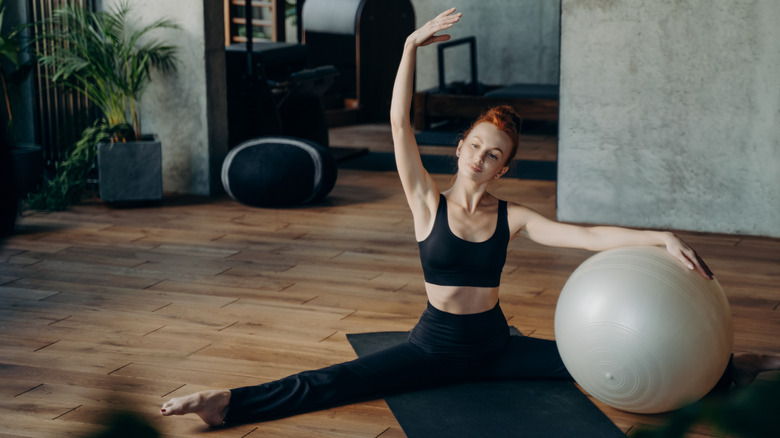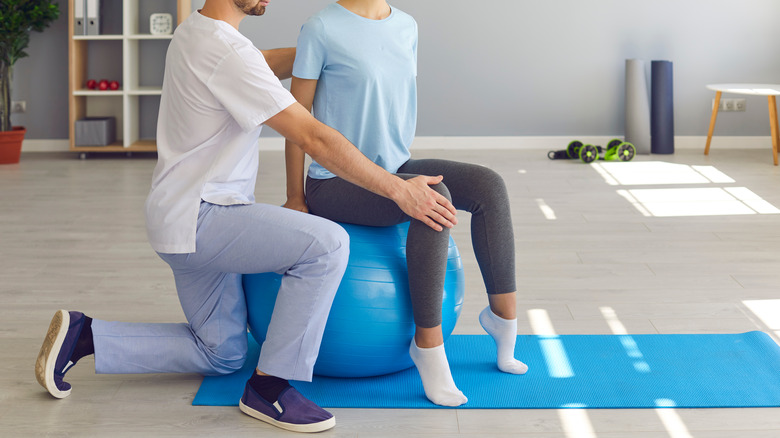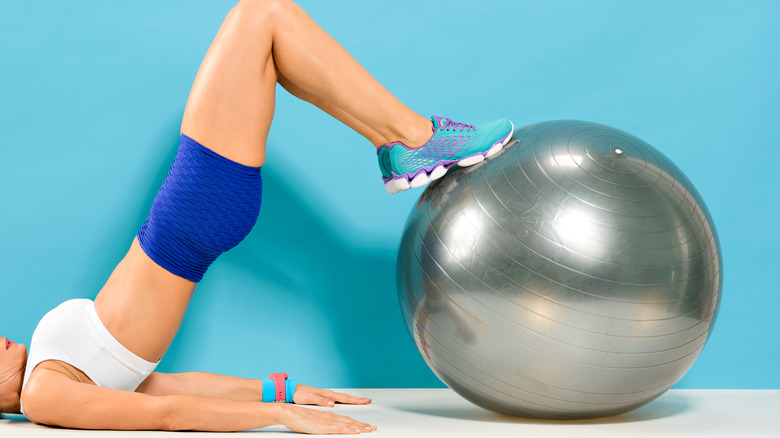Give Your Sore Muscles A Full-Body Workout With The Comfort Of A Stability Ball
Working out is an incredible way to show yourself some love, both mentally and physically. Some could even argue it's the self-care practice that outweighs the rest. But sometimes, when we jump back into it after a break or push ourselves extra hard, it doesn't feel so incredible. We wake up with sore muscles, and suddenly we're not as optimistic about our next trip to the gym. However, sore muscles should not deter you from moving your body. Physical therapist Dr. Corbin Hedt explained to the hospital Houston Methodist's medical blog, "Working out when sore is okay as long as it isn't affecting your movement to the point where it's causing you to compensate and do something in a way that's unsafe."
If you have been hyper-fixating on one kind of workout, though, it can be a smart idea to switch things up and take the focus off of the muscles you've repeatedly put through the wringer. Founder of Kika Stretch Method Kika Wise told Well+Good, "If you only run, for example, you're only mobilizing your body in one specific way." According to Wise, this could cause an imbalance in your muscle use which could then lead to injury.
If you've been overworking a muscle group, one gentle way to switch up your routine and challenge your whole body is by doing stability ball exercises. This is a great way to target difficult but important areas during a workout.
Benefits of a stability ball and what to know before buying one
A stability ball is a great piece of exercise equipment when your body and joints need a little more support. And, no matter what muscle group you focus on, when you incorporate a stability ball, you will find that your whole body is engaged. Certified personal trainer Paige Waehner wrote at Verwell Fit, "Anytime you're on an unstable surface, you work not just balance but other important things like coordination, stabilizer muscles, and, most importantly, the core."
However, to reap the benefits of a stability ball and avoid injury, you'll want to make sure you select the right ball. Physical Therapists Bob Schrupp and Brad Heineck demonstrate on their Youtube channel, Bob & Brad, what an improperly fitted ball looks like. Sitting on the ball with his feet on the ground, Heineck's knees sit above his waistline. However, the two explain that when you sit on the right-sized ball, your knees should land directly across from your hips. Once you have got the right ball for you, you're ready to try some exercises.
Full-body exercises you can do with a stability ball
Before you get started, you'll want to lay out an exercise mat. Then, to get your lower body fired up, try a hamstring curl variation. To start, rest your ankles on the top part of your ball while lying on your back. Grip the ball with your heels and bend your knees inwards, then slowly extend your legs back out. This workout will target your hamstrings while engaging your glutes, core, and quads. If you want to give yourself a little more of a challenge, try lifting your hips throughout the exercise, keeping your arms pressed to the floor for balance.
To keep things gentle on your arms when they are sore, put down the weights and pick up a stability ball. First, you'll want to sit on your knees, hip-distance apart, with your hands above your head resting on the ball in front of you. Your face should be facing the ground. Then, pressing into the ball and pushing it towards you, you'll want to lift into a standing position while on your knees. This exercise will target your lats while working your core, glutes, quads, biceps, and triceps. With simple, low-impact moves, you can target just about any area on the body using a stability ball, making it an awesome investment for your fitness regimen.



